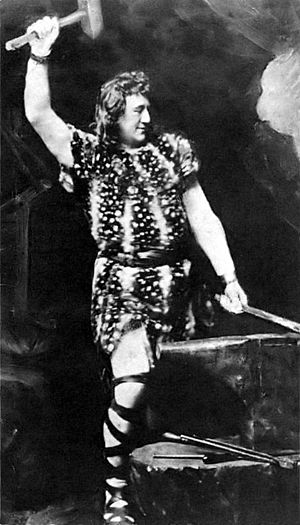Der Ring des Nibelungen facts for kids
Der Ring des Nibelungen (which means The Ring of the Nibelung) is a huge story told through four operas by a famous composer named Richard Wagner. It's like a giant musical adventure!
- The first opera is called Das Rheingold.
- The second opera is Die Walküre.
- The third opera is Siegfried.
- The fourth opera is Götterdämmerung.
You can find out more about each opera in their own separate articles. Sometimes, people call this group of four operas a "tetralogy," which just means four works that belong together as one big story.
Contents
The Story Behind the Ring
Wagner got the main ideas for his operas from an old German book called the Nibelungenlied. This book, written by an unknown German poet in the 12th century, tells tales of ancient gods and heroes from German mythology.
Wagner's Version of the Tale
Wagner changed the original story quite a bit to make it perfect for his operas. His version starts with a pile of shiny gold guarded by magical water spirits called the Rhinemaidens. A dwarf named Alberich steals this gold. He uses some of it to create a special ring that gives its owner amazing power over the whole world!
But when Wotan, the chief god, takes the ring from Alberich, the dwarf puts a terrible curse on it. This curse means that anyone who owns the ring will eventually die. The ring then passes through many different characters, and sadly, the curse always comes true, bringing death to each owner.
Who are the Nibelungs?
Alberich belongs to a group of dwarfs called the "Nibelungs." So, when you hear the title Der Ring des Nibelungen, it means "The Ring of the Nibelung," referring to Alberich and his people.
Why the Story is Powerful
The story of Wagner's Ring cycle might sound like a wild fairy tale. The characters are very different from real people. However, the story is powerful because it explores many basic human emotions. It's all about things like greed, love, and tricky situations. This is what makes it so interesting and relatable, even today.
Wagner's Amazing Music
Wagner's music in the Ring cycle is truly special. It perfectly matches each character and every situation. The music flows continuously, without breaks, throughout each act of the opera.
Musical Clues: Leitmotifs
Wagner used something he called leitmotifs. These are like musical clues! A leitmotif is a short tune, a special chord, or a little musical phrase that is connected to a specific person, object, or idea in the opera.
For example, there's a leitmotif for the curse on the ring. Whenever you hear this particular tune, you know that the curse is at work, even if no one says anything about it. It's a very clever way to tell the story through music!
Creating the Ring Cycle
Wagner spent about twenty years writing the Ring cycle! He started in the 1850s while living in Switzerland. He wrote all the words for the operas himself, which is called the libretto. He always wrote his own librettos for his operas.
By 1857, he had finished the first two operas and most of Siegfried. It took many more years before he finally finished Siegfried and wrote the last opera, Götterdämmerung.
A Special Opera House
Wagner dreamed of having his Ring cycle performed in a very special opera house built exactly the way he wanted. He needed a lot of money for this big idea. Luckily, he found someone who loved his music and was happy to give him a lot of money: King Ludwig II of Bavaria.
Wagner first told the King that the Ring cycle would be performed in Munich, which was the capital city of Bavaria. But later, it seemed too difficult to build a new opera house there. So, Wagner decided to build his opera house in Bayreuth instead. King Ludwig didn't seem to mind and continued to support Wagner with money for the project and even a nice house to live in.
Das Rheingold was first performed in Munich in 1869, and Die Walküre followed in 1870. The entire Ring cycle was finally performed together for the first time in 1876. This grand premiere took place in the new opera house, called the Festspielhaus, in Bayreuth.
Images for kids
-
Illustration of Brünnhilde by Odilon Redon, 1885
-
Gwyneth Jones performing at the 1976 Bayreuth production of Der Ring des Nibelungen, conducted by Pierre Boulez and directed by Patrice Chéreau
See also
 In Spanish: El anillo del nibelungo para niños
In Spanish: El anillo del nibelungo para niños






